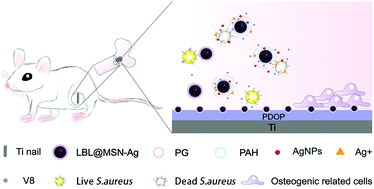当前位置:
X-MOL 学术
›
Biomater. Sci.
›
论文详情
Our official English website, www.x-mol.net, welcomes your
feedback! (Note: you will need to create a separate account there.)
A dual-functional implant with an enzyme-responsive effect for bacterial infection therapy and tissue regeneration.
Biomaterials Science ( IF 5.8 ) Pub Date : 2020/01/03 , DOI: 10.1039/c9bm01924c Yao Ding 1 , Yansha Hao 1 , Zhang Yuan 1 , Bailong Tao 1 , Maowen Chen 1 , Chuanchuan Lin 1 , Peng Liu 2 , Kaiyong Cai 2
Biomaterials Science ( IF 5.8 ) Pub Date : 2020/01/03 , DOI: 10.1039/c9bm01924c Yao Ding 1 , Yansha Hao 1 , Zhang Yuan 1 , Bailong Tao 1 , Maowen Chen 1 , Chuanchuan Lin 1 , Peng Liu 2 , Kaiyong Cai 2
Affiliation

|
Biomaterial-associated bacterial infection is one of the major causes of implant failure. The treatment of such an implant infection typically requires the elimination of bacteria and acceleration of tissue regeneration around implants simultaneously. To address this issue, an ideal implanted material should have the dual functions of bacterial infection therapy and tissue regeneration at the same time. Herein, an enzyme-responsive nanoplatform was fabricated in order to treat implant-associated bacterial infection and accelerate tissue regeneration in vivo. Firstly, Ag nanoparticles were pre-encapsulated in mesoporous silica nanoparticles (MSNs) by a one-pot method. Then, poly-l-glutamic acid (PG) and polyallylamine hydrochloride (PAH) were assembled by the layer-by-layer (LBL) assembly technique on MSN-Ag to form LBL@MSN-Ag nanoparticles. Furthermore, the LBL@MSN-Ag nanoparticles were deposited on the surface of polydopamine-modified Ti substrates. PG is a homogeneous polyamide composed of an amide linkage, which can be degraded by glutamyl endonuclease secreted by Staphylococcus aureus. Inductively coupled plasma spectroscopy (ICP) results proved that the LBL@MSN-Ag particles show a significant enzyme responsive release of Ag ions. Furthermore, results of antibacterial experiments in vitro showed that the Ti substrates modified with an LBL@MSN-Ag nanocoating presented an excellent antibacterial effect. As for an animal experiment in vivo, in a bacterium infected femur-defect rat model, the modified Ti implants effectively treated bacterial infection. More importantly, the results of micro-CT, haematoxylin-eosin staining and Masson's trichrome staining demonstrated that the modified Ti implants significantly promoted the formation of new bone tissue after implantation for 4 weeks. The present system paves the way for developing the next generation of implants with the functions of treating bacterial infection and promoting tissue regeneration.
中文翻译:

具有酶反应作用的双功能植入物,用于细菌感染治疗和组织再生。
生物材料相关细菌感染是植入失败的主要原因之一。这种植入物感染的治疗通常需要消除细菌并同时加速植入物周围的组织再生。为了解决这个问题,理想的植入材料应同时具有细菌感染治疗和组织再生的双重功能。在本文中,制造酶反应性纳米平台以治疗植入物相关细菌感染并加速体内组织再生。首先,通过一锅法将Ag纳米颗粒预先封装在介孔二氧化硅纳米颗粒(MSNs)中。然后,通过层-层(LBL)组装技术将聚-1-谷氨酸(PG)和聚烯丙胺盐酸盐(PAH)组装在MSN-Ag上,以形成LBL @ MSN-Ag纳米颗粒。此外,LBL @ MSN-Ag纳米颗粒沉积在聚多巴胺改性的Ti基材表面上。PG是由酰胺键组成的均质聚酰胺,可被金黄色葡萄球菌分泌的谷氨酰内切核酸酶降解。电感耦合等离子体光谱法(ICP)结果证明,LBL @ MSN-Ag颗粒显示出显着的酶响应性释放Ag离子。此外,体外抗菌实验的结果表明,用LBL @ MSN-Ag纳米涂层改性的Ti基体具有出色的抗菌效果。至于体内的动物实验,在细菌感染的股骨缺损大鼠模型中,修饰的Ti植入物有效地治疗了细菌感染。更重要的是,显微CT,苏木精-伊红染色和Masson' 的三色染色表明,改性钛植入物在植入4周后可显着促进新骨组织的形成。本系统为开发具有治疗细菌感染和促进组织再生功能的下一代植入物铺平了道路。
更新日期:2020-03-31
中文翻译:

具有酶反应作用的双功能植入物,用于细菌感染治疗和组织再生。
生物材料相关细菌感染是植入失败的主要原因之一。这种植入物感染的治疗通常需要消除细菌并同时加速植入物周围的组织再生。为了解决这个问题,理想的植入材料应同时具有细菌感染治疗和组织再生的双重功能。在本文中,制造酶反应性纳米平台以治疗植入物相关细菌感染并加速体内组织再生。首先,通过一锅法将Ag纳米颗粒预先封装在介孔二氧化硅纳米颗粒(MSNs)中。然后,通过层-层(LBL)组装技术将聚-1-谷氨酸(PG)和聚烯丙胺盐酸盐(PAH)组装在MSN-Ag上,以形成LBL @ MSN-Ag纳米颗粒。此外,LBL @ MSN-Ag纳米颗粒沉积在聚多巴胺改性的Ti基材表面上。PG是由酰胺键组成的均质聚酰胺,可被金黄色葡萄球菌分泌的谷氨酰内切核酸酶降解。电感耦合等离子体光谱法(ICP)结果证明,LBL @ MSN-Ag颗粒显示出显着的酶响应性释放Ag离子。此外,体外抗菌实验的结果表明,用LBL @ MSN-Ag纳米涂层改性的Ti基体具有出色的抗菌效果。至于体内的动物实验,在细菌感染的股骨缺损大鼠模型中,修饰的Ti植入物有效地治疗了细菌感染。更重要的是,显微CT,苏木精-伊红染色和Masson' 的三色染色表明,改性钛植入物在植入4周后可显着促进新骨组织的形成。本系统为开发具有治疗细菌感染和促进组织再生功能的下一代植入物铺平了道路。










































 京公网安备 11010802027423号
京公网安备 11010802027423号